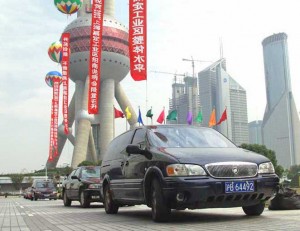
A Buick van in Shanghai, where General Motors is now among the leading makers.
For a long time, General Motors executives have insisted — often quite vociferously — that they had a serious plan for restoring the company to profitability. The company’s multi-dimensional strategy would pay huge dividends at some point in the future, they repeatedly promised during the years George W. Bush occupied the White House.
The strategy set in place by former GM chairman Jack Smith, which was built around the company’s broad overseas expansion, is increasingly unlikely to survive the company’s dramatic restructuring. During the Bush-era, however, talking about the strategy quite frequently helped GM’s executives divert attention from the missteps that have now left the company locked into a destructive downward spiral.
The conventional analysis that’s emerged in the wake of the first part of what is likely to become a multi-stage rescue of GM has been that the company’s union contracts — particularly the health-care benefits that have become steadily more expensive over the past decade — have crippled the company. But GM also labored under expensive union contracts and dysfunctional labor-relations during its glory years in the 1950s, ’60s and ’70s.
Far less attention, however, has been paid to the heavy cost of GM’s lavish overseas expansion in far flung markets such as China, Thailand, South Korea, Russia, Eastern Europe and even Central Asia, which was basically done using the corporate equivalent of credit cards – medium-term corporate debt. True, the prospectus for at least one of the major bond issues back in 2003 cited the need to shore up pension funds and employee benefit accounts. But once it hits GM’s corporate treasury, the proceeds from a corporate bond sale are cash. And cash, as accounting professors note, is fungible, meaning the money also financed GM’s broad expansion overseas.

What happens if GM abandons Opel?
The impact of the heavy borrowing appeared to pay ample dividends. Sales in far-off places grew enormously and GM’s center of gravity even appeared to shift abroad as overseas sales grew from barely a quarter of the company’s total to more than half, in recent years.
It sounded great. But, basically, GM was in the same position as an overextended homeowner betting on future raises and increases in home equity to help make the mortgage payment. Unfortunately, like a lot of would-be homeowners, GM lost its bet and is now in the midst of the most serious financial crisis in its 100-year history.
The bond-holders who lent money for the overseas ventures haven’t budged, yet, and the union, which also became one of GM’s creditors in 2007, is balking at returning a portion of the cash it obtained during the negotiations of two years ago and trading it for equity.
Meanwhile, the debate over the fate of Adam Opel AG, in Germany, illustrates how the financial pressure created by the deep recession has now reduced GM’s vaunted strategy to a complete shambles.
GM can easily afford to let go of Saab, which declared bankruptcy in Sweden last week. Saab has been little more than a distraction. However, while Opel executives have grumbled, GM’s German subsidiary and its engineering and designs were as critical to GM’s expansion in Asia and Eastern Europe as the money raised on Wall Street.
If Opel collapses, or is sold, or is dramatically downsized, as seems increasingly likely, GM’s strategy and its ability to engineer passenger cars around the world would be reduced to a shell. Some engineering could come from Korea, but the Korean government has balked at giving GM financial help. The fact that GM is even thinking of letting Opel go after more than 70 years, underscores how desperate the humbled U.S. giant, and its executives, have become.
Click here for the Saab bankruptcy story.
